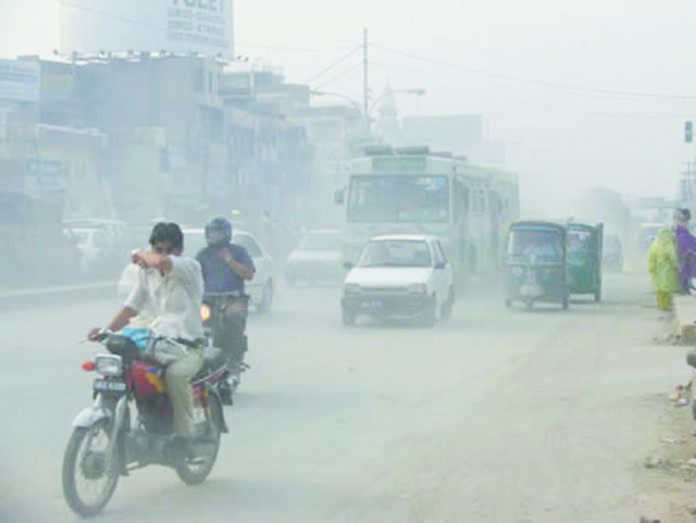Controlling smog air pollution has proved to be a difficult task worldwide, due to the gigantic area of its spread. Very few countries, and only with help and active coordination of their residents, have been able to lower the ever increasing air pollution, indoor and outdoor alike. It is almost impossible that a government without active participation of people, would be able to control it. Therefore apart from Government efforts, we as individuals will have to take responsibility and play our part.
In recent years, Pakistan, particularly in Lahore, has been grappling with a growing concern– air pollution. Lahore has consistently ranked among the world’s most polluted cities for many years, facing significant air quality issues. Every year between October and January, the visible smog (a portmanteau of “smoke” and “fog,” it is a visible manifestation of severe air pollution), an ominous blend of pollutants, hangs in the air, affecting the health, productivity, and overall well-being of its residents.
The adverse effects of air pollution have become increasingly evident, necessitating urgent measures to mitigate its impact. In this article, I emphasize the significance of installing air purifiers in public and private institutions as a proactive step towards combating air pollution in Pakistan.
Lahore’s struggle with air pollution gained public attention in early 2017 when citizen-operated sensors began monitoring PM2.5 (Particulate Matter 2.5, refers to tiny airborne particles with a diameter of 2.5 micrometers or smaller, which can penetrate deep into the respiratory system and have adverse health effects when inhaled). The startling findings shocked the public, leading to a petition that prompted Lahore’s High Court to order an updated smog response action plan. Subsequently, the Punjab Environment Protection Council adopted an Air Quality Index (AQI) classification system. However, criticism arose, with concerns that Punjab’s AQI was too lenient, downplaying the severity of pollution compared to international standards. For instance, a PM2.5 concentration that the US AQI deems “Unhealthy” is categorized as “Satisfactory” in Punjab, with a warning limited to minor breathing discomfort for sensitive individuals.
Air pollution results from a complex interplay of natural and human-induced factors. Common sources of air pollution in the city encompass vehicular emissions, industrial activities, construction-related dust, agricultural burning, domestic heating and cooking practices, waste burning, meteorological conditions, power plant emissions, natural events like dust storms and wildfires, and the use of inefficient energy sources. This multifaceted combination of factors contributes to the persistent air quality challenges and the formation of smog in Lahore, emphasizing the need for comprehensive mitigation measures.
In Lahore, the average daily wind speeds for October, November, December, and January have been relatively mild, ranging from 4 to 5 km/h (equivalent to 2 to 3 mph or 2 to 3 knots) and the average temperatures during these months, which hover around 20°C. The slower wind speeds and relatively cold weather contribute to the accumulation of air pollutants in one area, leading to the formation of smog, as compared with higher average wind speeds of 12-15 km/h and warm weather that disperse pollutants more effectively. (Based on data collected over the past two decades)
According to the Pakistan Bureau of Statistics (Households Population 2023), Lahore is home to a substantial population of 22,772,710, and this population has witnessed a notable growth rate since 2017. The magnitude of this population, combined with the persistently high levels of air pollution, underscores the significant number of people in Lahore who are exposed to the adverse effects of deteriorating air quality.
In addition to efforts of the Government to control air pollution, it is urged to all relevant stakeholders, including educational institutions, government agencies, and private organizations, to conduct a thorough cost-benefit analysis regarding the installation of air purifiers in buildings where people gather in large numbers.
Air pollution is more than just an environmental issue; it is a major public health concern. Fine particulate matter, or PM2.5, present in polluted air, can infiltrate our respiratory systems, causing or exacerbating respiratory conditions like asthma and bronchitis. Long-term exposure to air pollution has been linked to cardiovascular diseases, including heart attacks and strokes. Pregnant women and children are particularly vulnerable, with potential health risks ranging from preterm births to developmental issues.
Pakistan is grappling with a severe air pollution crisis, ranking as the world’s fourth most polluted country. The consequences of this alarming pollution are stark, with fine particulate air pollution, or PM2.5, significantly shortening the average life expectancy of Pakistani residents. It is the second greatest threat to human health in the country, just behind cardiovascular diseases. According to data, PM2.5 pollution leads to a substantial reduction of 3.9 years in the life expectancy of the average Pakistani from what it would be if the World Health Organization (WHO) guideline of 5 µg/m³ were met. In regions such as Lahore, Kasur, and Peshawar, where air pollution is at its worst, lives are shortened by nearly 7 years. This crisis extends nationwide, as all 238 million Pakistanis reside in areas where annual average particulate pollution levels exceed the WHO guideline, and a staggering 98.3 percent of the population lives in areas surpassing the country’s own national air quality standard of 15 µg/m³. (Air Quality Life Index, 2023)
Poor air quality is not confined to its health implications; it also affects economic productivity. Individuals affected by air pollution often experience reduced cognitive function and increased absenteeism due to health issues, which inevitably lead to decreased productivity. Workers in outdoor industries like construction and agriculture are directly impacted as they are exposed to pollution throughout the workday.
The economic burden of air pollution cannot be overstated. Increased healthcare costs resulting from air pollution-related illnesses place significant strain on the healthcare system. Businesses suffer financial losses due to decreased employee productivity and increased healthcare expenses. Furthermore, smog and air pollution disrupt daily activities and transportation, leading to additional economic losses.
Several countries in Asia affected by air pollution have recognized the importance of air purifiers in combating air pollution. Notably, China and India have been at the forefront of adopting air purification technologies. In China, cities like Beijing and Shanghai have extensively used air purifiers in residential, commercial, and public spaces. In India, where cities like Delhi have been facing persistent air quality challenges, air purifiers have gained popularity in homes, schools, and offices. Furthermore, local air quality management and environmental agencies have been actively monitoring and controlling air quality in major cities. Public awareness campaigns have also emphasized the significance of air purifiers in homes and educational institutions to safeguard health.
South Korea, Japan, and Taiwan are among the other Asian nations with a growing awareness of the benefits of air purifiers. Most notably, Singapore is known for its proactive approach to environmental issues, and has also recognized the importance of air purification. The National Environment Agency provides guidelines for selecting air purifiers and emphasizes their role in improving indoor air quality. Singaporeans are encouraged to choose air purifiers with HEPA filters, which are effective in trapping fine particles like PM2.5. Additionally, Singapore’s strong air quality monitoring and early warning system provide timely information to the public, allowing them to take preventive measures, including the use of air purifiers, on days with elevated air pollution levels.
When considering the installation of air purifiers in educational institutions and government buildings, several factors come into play. These include the specific air quality needs of the building, budget planning, vendor selection, cost estimation, and budget for ongoing maintenance. Additionally, assessing the energy efficiency of air purifiers, exploring financing options, seeking support from government or institutional funding, and fostering public awareness and community involvement are essential considerations. It is vital to consult with indoor air quality experts and conduct a cost-benefit analysis to determine the most cost-effective and efficient solution for a particular building or institution.
By considering these factors and learning from the experiences of countries like India and Singapore, Pakistan can proactively address its air pollution concerns by implementing air purifiers in public and private institutions, ultimately improving the health and well-being of its citizens. Air purifiers can significantly reduce indoor air pollution, thereby safeguarding the health of building occupants and enhancing their productivity. Educational institutions, where the health and performance of students and staff are paramount, should take particular note of this solution.
The Government of Punjab, on its own and on the direction of Honourable Lahore High Court, Lahore have taken measures to combat Smog Air Pollution, in the past. Lately, Section 144 has been imposed in Lahore, placing restrictions on certain activities that contribute to pollution. Under the Smog Rules of the Punjab Government, severe penalties have been proposed for various activities that significantly contribute to pollution. Kilns and factories found in violation will face a hefty fine of Rs 500,000. Burning waste, a common practice contributing to pollution, will be met with a fine of Rs 10,000. In addition, a fine of Rs 4000 will be imposed on vehicles emitting excessive smoke.
In addition to efforts of the Government to control air pollution, it is urged to all relevant stakeholders, including educational institutions, government agencies, and private organizations, to conduct a thorough cost-benefit analysis regarding the installation of air purifiers in buildings where people gather in large numbers. It is imperative that we assess the economic and health benefits that this measure can bring. By conducting such an analysis, we can objectively determine whether the investment in air purifiers is justified, as being made in other parts of the world.























